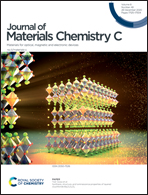Enhanced energy density and extraction efficiency of polar sol–gel dielectric films with reduced residual ions
Abstract
We report on the effect of residual ions in dielectric sol–gel films based on 2-cyanoethyltrimethoxysilane (CNETMS) on their dielectric and energy storage properties for pulsed power applications. A wide range of pH from 1.5 to 6.5 is employed to catalyze CNETMS sol–gel films. The sol–gel films processed at near neutral pH exhibit improved dielectric and energy storage characteristics including a Weibull modulus of 11, an order of magnitude reduction of leakage current, and an extractable energy density of 32 J cm−3 with an energy extraction efficiency of 80% at 685 V μm−1, as compared with the films processed at pH 1.5. These improvements are attributed to the reduced amount of ions within the sol–gel films, which is believed to suppress the detrimental effects of mobile charge carriers that are likely to trigger field-driven scattering and impact ionization, and subsequent catastrophic electrical breakdown under high electrical stress. The present work suggests the importance of engineering residual charge carriers in dielectric sol–gel films based on trifunctional alkoxysilanes for pulsed power applications.



 Please wait while we load your content...
Please wait while we load your content...
